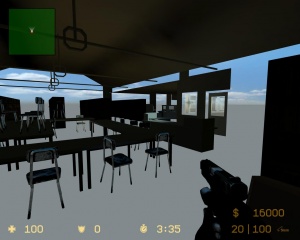Invisible Textures: Difference between revisions
Jump to navigation
Jump to search
No edit summary |
No edit summary |
||
| Line 1: | Line 1: | ||
Only by constant testing did I find the problem of flickering invisible to visible textures. Its cause, is having too many "clipped" brushes causing a sort of corruption in the compiled bsp | Only by constant testing did I find the problem of flickering invisible to visible textures. Its cause, is having too many "clipped" brushes causing a sort of corruption in the compiled bsp. | ||
*By "clipped" i mean using the Clipping Tool | *Try deleting as many clipped brushes as possible and make then more simple by just having a cube rather than smoothed edges. | ||
or | |||
*Turning these clipped objects into a func_brush actually fixes this problem. Making then func_detail's can cause some problems like T junction compile errors, so stick to the func_brush's. | |||
(By "clipped" i mean using the Clipping Tool) | |||
[[Image:Invisible_texture_problem.JPG|thumbnail|This is an example of invisible textures.]] | [[Image:Invisible_texture_problem.JPG|thumbnail|This is an example of invisible textures.]] | ||
Revision as of 16:50, 9 May 2009
Only by constant testing did I find the problem of flickering invisible to visible textures. Its cause, is having too many "clipped" brushes causing a sort of corruption in the compiled bsp.
- Try deleting as many clipped brushes as possible and make then more simple by just having a cube rather than smoothed edges.
or
- Turning these clipped objects into a func_brush actually fixes this problem. Making then func_detail's can cause some problems like T junction compile errors, so stick to the func_brush's.
(By "clipped" i mean using the Clipping Tool)
